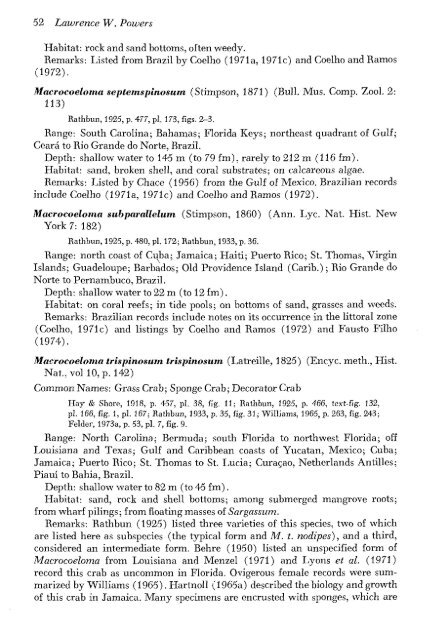Create successful ePaper yourself
Turn your PDF publications into a flip-book with our unique Google optimized e-Paper software.
52 Lawrence W. Powers<br />
Habitat: rock and sand bottoms, often weedy.<br />
Remarks: Listed from Brazil by Coelho (IQZla, 1971c) and Coelho and Ramos<br />
(1972).<br />
Macrocoeloma septemspinosum (Stimpson, 1871) (Bull. Mus. Comp. Zool. 2:<br />
113)<br />
Rathbun, 1925, p. 477, pi. 173, figs. 2^3.<br />
Range: South Carolina; Bahamas; Florida Keys; northeast quadrant of Gulf;<br />
Ceara to Rio Grande do Norte, Brazil.<br />
Depth: shallow water to 145 m (to 79 fm), rarely to 212 m (116 fm).<br />
Habitat: sand, broken shell, and coral substrates; on calcareous algae.<br />
Remarks: Listed by Chace (1956) from the Gulf of Mexico. Brazilian records<br />
include Coelho (1971a, 1971c) and Coelho and Ramos (1972).<br />
Macrocoeloma suhparallelum. (Stimpson, 1860) (Ann. Lye. Nat. Hist. New<br />
York 7: 182)<br />
Rathbun, 1925, p. 480, pi. 172; Rathbun, 1933, p. 36.<br />
Range: north coast of Cuba; Jamaica; Haiti; Puerto Rico; St. Thomas, Virgin<br />
Islands; Guadeloupe; Barbados; Old Providence Island (Carib.); Rio Grande do<br />
Norte to Pernambuco, Brazil.<br />
Depth: shallow water to 22 m (to 12 fm).<br />
Habitat; on coral reefs; in tide pools; on bottoms of sand, grasses and weeds.<br />
Remarks: Brazilian records include notes on its occurrence in the littoral zone<br />
(Coelho, 1971c) and listings by Coelho and Ramos (1972) and Fausto Filho<br />
(1974).<br />
Macrocoeloma Irispinosum trispinosum. (Latreille, 1825) (Encyc. meth.. Hist.<br />
Nat, vol 10, p. 142)<br />
Common Names: Grass Crab; Sponge Crab; Decorator Crab<br />
Hay & Shore, 1918, p. 457, pi. 38, fig. 11; Rathbun, 1925, p. 466, te.vt-fig. 132,<br />
pi. 166, fig. 1, pi. 167; Rathbun, 1933, p. 35, fig. 31; Williams, 1965, p. 263, fig. 243;<br />
Felder, 1973a, p. 53, pi. 7, fig. 9.<br />
Range: North Carolina; Bermuda; south Florida to northwest Florida; off<br />
Louisiana and Texas; Gulf and Caribbean coasts of Yucatan, Mexico; Cuba;<br />
Jamaica; Puerto Rico; St. Thomas to St. Lucia; Curasao, Netherlands Antilles;<br />
Piaui to Bahia, Brazil.<br />
Depth: shallow water to 82 m (to 45 fm).<br />
Habitat: sand, rock and shell bottoms; among submerged mangrove roots;<br />
from wharf pilings; from floating masses of Sargassum.<br />
Remarks: Rathbun (1925) listed three varieties of this species, two of which<br />
are listed here as subspecies (the typical form and M. t. nodipes), and a third,<br />
considered an intermediate form. Behre (1950) listed an unspecified form of<br />
Macrocoeloma from Louisiana and Menzel (1971) and Lyons et al. (1971)<br />
record this crab as uncommon in Florida. Ovigerous female records were summarized<br />
by Williams (1965). Hartnoll (1965a) described the biology and growth<br />
of this crab in Jamaica. Many specimens are encrusted with sponges, which are

















